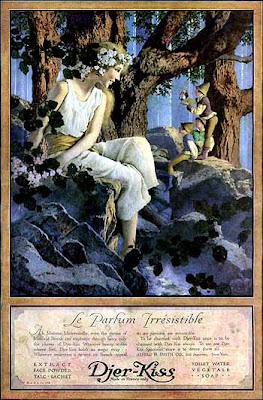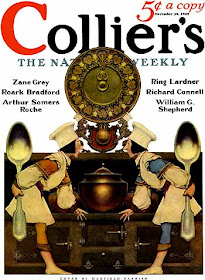 |
| Dinky Bird, 1904, from Eugene Field's Poems of Childhood. |
When I was 19, a friend gave me a poster of the above work by Maxfield Parrish. She said it reminded her of me. I was very pleased, as I fell in love with it upon first sight. She was about a decade older than me and had been a real hippie, so I was especially flattered. It hung in every bedroom I had until it finally got damaged in a move. But the dreamy print always made me feel peaceful, and was my first piece of art as an adult.
 |
| Princess Parizade Bringing Home the Singing Tree, 1906, from Arabian Nights. |
Frederick Parrish was born in Philadelphia in 1870. He later adopted his maternal grandmother's maiden name as his middle one, Maxfield, eventually using it professionally. His father, Stephen, was an engraver and landscape artist, and his parents encouraged him. He was doodling even as a child. He once studied architecture, which is evident in many of his later paintings, but it was in drawing and painting that he concentrated his efforts.
 |
| One of his drawings as a teenager. Image from Young Maxfield Parrish by John Goodspeed Stuart, T.H. Pickens Technical Center, 1992. |
His first commissions were to illustrate L. Frank Baum's Mother Goose in Prose, and Kenneth Grahame's The Walls Were as of Jasper for Scribners Magazine, in 1897. All of his 19th century illustrations were in black & white. It was in a subsequent period that he began painting in the colors he became and remains famous for - particularly "Parrish blue". When he was thirty, he came down with tuberculosis. He went to Arizona to recuperate, and that's when his career took off.
 |
| The Walls Were as of Jasper, 1897, Scribners Magazine. |
 |
| The Golden Age, from a 1904 photogravure edition. This and the image above courtesy of the book The Black & White Parrish, Thumb Tack Books, 1982. |
He illustrated Eugene Field's Poems of Childhood in 1905, and The Arabian Nights in 1909; in 1910 he illustrated A Wonder Book and Tanglewood Tales. He had many magazine commissions in the 1910s and 1920, including Hearst's, Collier's, and Life. He was also a favorite of advertisers, including Edison-Mazda Lamps, Colgate, and Oneida Cutlery.
 |
| A 1918 ad for Djer-Kiss. |
In 1905, a 16-year-old woman, Susan Lewin, came to work for his family as his son's nanny. She became his assistant and a favorite model (mostly in the 1920s); then eventually they became lovers. His wife left him in 1911; however Susan remained with him for over 50 years.
 |
| Collier's, November 1929. |
His androgynous nudes in fantasy settings were a recurring theme, but in the 1920s he turned from illustration and concentrated on painting for pleasure. He lived off the royalties from his posters and calendars, then in 1931 he declared he was through with "girls on rocks". He directed his attention to landscapes, and often built models and lit them as preparation for his paintings.
 |
| White Birches, 1952. |
Photographs do not do his paintings justice. He worked in oils on stretched paper. He would apply numerous layers of thin, transparent oil, alternating with varnish, which lead to high luminosity, a process called glazing. He also photographed, enlarged, or traced figures and objects, then cut them out and placed them on his works and covered them with thick, clear layers of glaze, giving them a three dimensional appearance.
 |
| Cadmus Sowing the Dragon's Teeth, 1910, in A Wonder Book and Tanglewood Tales by Nathaniel Hawthorne. |
Although it was Air Castles (a 1904 Ladies' Home Journal cover) that gave him wide exposure, Daybreak is considered his masterpiece. His work was widely reproduced in posters, calendars, and candy box lids, and is still in demand. By the time of his death at age 95 in 1966, he was able to see a renaissance of interest and promotion of his work. He was the most popular American artist from the turn of the century until the 1940s, when Norman Rockwell became his heir apparent.
 |
| Air Castles. |
.jpg) |
| Daybreak. |
Maxfield Parrish shaped the Golden Age of illustration, and influenced American visual arts for decades. His work experiences new surges of interest as each new generation discovers it. Daybreak is considered the most popular art print of the 20th century, judging from the number of prints that have been made. It has outsold Warhol's Campbell's Soup Cans and even Da Vinci's Last Supper, and is still in print. By all accounts he was affable and well-liked. How fortunate to be so successful at doing what you love!
***************
Unless otherwise noted, all images courtesy of Wikipedia.
The National Museum of American Illustration has the largest body of his works.
This website has interesting information on Parrish.
*******************************
Interesting and enjoyable to read.
ReplyDeleteI'm obviously way late to the party here, Linda; just happening upon this post several months after the fact. But I'm so happy to have found your blog!
ReplyDeleteThank you for this thoughtful and informative piece on my favorite American artist. Maxfield Parrish was my idol as a young illustration student back in the late 70s, a time when his work was making one of its many generational resurgences. And try as did to in some way mimic his genius, it only made me appreciate his wonderful artistry even more.
Several years ago, in 2005, I experienced one of the great thrills of my lifetime when an exhibition featuring many of Parrish's most notable works stopped in Memphis, TN. Although we live 200 miles away in Nashville, there was NO WAY I was gonna miss the chance to see it. The stop in Memphis was to be one of the limited national tour's last, and just prior to when a number of the pieces in the collection would be returned to the private collections from which they came; some, it was surmised, might never be exhibited in public again.
So you can imagine my joy at the opportunity to experience the original Daybreak from less than a few feet away -- still so amazingly vibrant; it was breathtaking! And you are so right -- no photograph could do most of Parrish's works justice (although I WAS also quite jazzed to have been able to sneak a quick camera phone pic of Daybreak when the guards weren't looking...and it came out surprisingly good!).
But thank you again, Linda, for this awesome diversion. It's been awhile since I've had a 'Max' encounter. :)
Thanks, AJ, for the compliments and for sharing your experience. I would have loved to have seen that exhibit, and the colors of the real work! I still find viewing his work to be relaxing and it eases my stress...
ReplyDelete